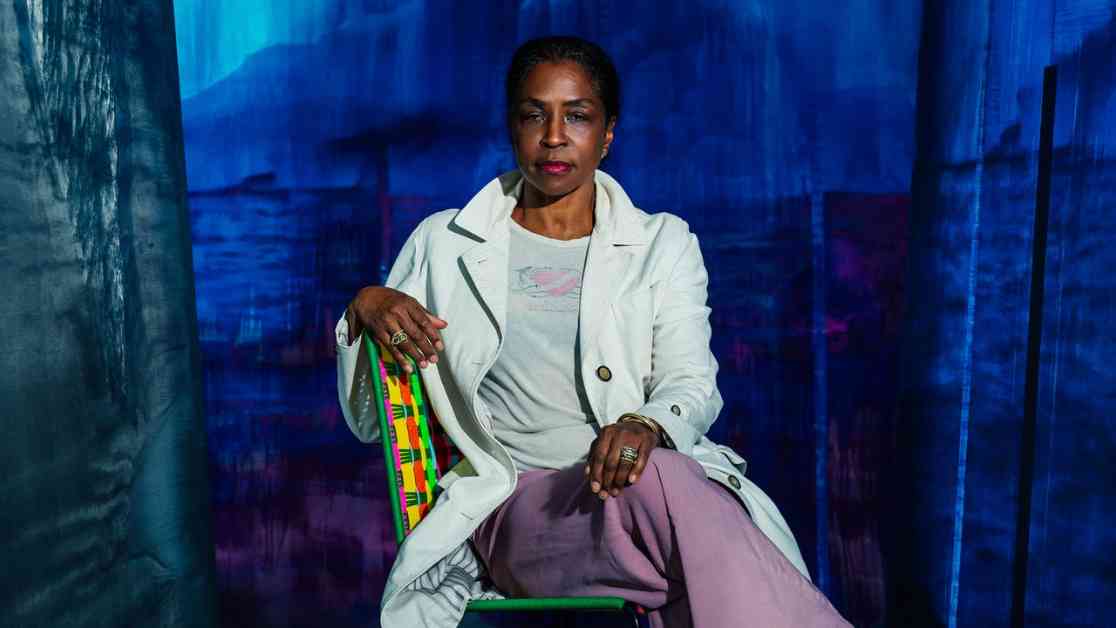Lorna Simpson found the meteorite on eBay. “It was for a great price,” she told me, declining to give the exact figure, though she later admitted that it had cost about six thousand dollars. The seller was “some guy upstate” who’d never listed anything comparable and provided no proof of its celestial provenance. But when it was finally delivered—to her airy studio in the Brooklyn Navy Yard, where I’d come to see her on a February afternoon—magnets clung to its dimpled surface. “I’ve got this idea—it’s meteorites! ” she mimed telling her gallery, Hauser & Wirth, affecting the voice of an exuberant naïf. Simpson knit her eyebrows: “They were, like, ‘O.K.’ ” She began screen-printing photos of meteorites onto fibreglass panels, then painted over them in silvery hues. Last November, she exhibited the results in a show called “Earth & Sky,” placing the meteorite itself in a corner of the gallery.
Simpson is contemporary art’s astronomer of the archives, always searching for the dark matter that “documentary” images conceal. This most recent suite was inspired by a photo of a meteorite in an antique geology textbook, whose caption described its near-collision with an unnamed sharecropper in nineteen-twenties Mississippi. His strange destiny—chosen by the heavens, erased by Jim Crow—obsessed her. Now a work from the series has been acquired by the Metropolitan Museum of Art, and will feature in its retrospective of Simpson’s paintings later this month.
“I look for an image that’s already crazy, and then just do a little bit more,” she said over pastries, handing me a Jet pinup calendar from 1972. Like Mitt Romney, Simpson keeps binders full of women. Some of her paintings begin as digital collages sourced from vintage Black magazines; this calendar’s smiling, topless cover model had accessorized her lingerie with a bandolier of bullets, as though in preparation for the revolution.
We were seated on a couch surrounded by old books and mineral specimens, an island of clutter and coziness in a sparse, white-columned expanse. Paintings leaned against the wall to one side. On the other, beneath a wide window with a view of the Manhattan skyline, a collaging table was heaped with paper scraps. Miss Black America, in a fur stole, advertised sparkling wine; near a clipping of an African sculpture, wig models beamed. With scissors and glue, any one of these might become a sky goddess or a chimera, acquiring that aura of mysterious privacy which has been Simpson’s trademark since the nineteen-eighties, when she broke out with a series of photo-texts depicting Black women whose faces never appear.
They were clean, placeless silver-gelatin-print portraits, taken from behind or from the neck down, or substituting isolated body parts for absent figures. Their fragmentary captions undercut reflexive assumptions; in the words of the artist and writer Coco Fusco, they “came to stand for a generation’s mode of looking and questioning photographic representation.” Perhaps the most celebrated is “Waterbearer” (1986). A young woman in a sleeveless white dress, her back turned to the camera, empties a silver pitcher with one hand and a plastic jug with the other. “She saw him disappear by the river, they asked her to tell what happened, only to discount her memory,” the caption reads. The image has become an icon of Black feminist self-reclamation. Refusing to accede the viewer’s curiosity while inviting speculation, it is also emblematic of Simpson’s singular slyness, which sets her apart from the contemporary efflorescence of Black portraiture that her work helped to inspire. “People are comforted by a rendering of a figure,” she said. “Nothing wrong with that. It satisfies a particular kind of desire around presence. For me? I like to complicate.”
Simpson is a slender, dark-skinned woman with angular cheekbones and heavy-lidded eyes, frequently narrowed in contemplation or amusement. She has a halo of springy black curls, touched with gray at the roots, worn in a bun at the studio. Glamorous yet chicly casual, she was dressed in silky sage trousers embroidered with dragons and indigo-stained Uggs. She speaks unhurriedly in a delicate, sweetly thickened voice, as if she’s just swallowed a spoonful of honey. But her hearty laugh drops into a lower register—as when she confessed to accidentally skipping an appearance at a commencement ceremony headlined by Michelle Obama, which she forgot about amid a divorce-related ordeal. Her right arm is inked with sinuous tattoos from Tahiti, where she vacationed after the separation; one constant of her practice is a readiness to move on.












